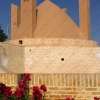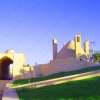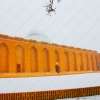Introducing Kolar Ab Anbar
The historical monument, Kolar Ab Anbar (water reservoir), is located outside the old wall alongside the historical city of Meybod such as Shah Abbasi Caravanserai, Chaparkhaneh (pony Meybod Yakhchalexpress), etc.
Kolar Ab Anbar dates back to 1070s AH (Safavid Era), according to a historical inscription mounted on the wall. This Ab anbar is located right in front of the entrance door to Shah Abbasi Caravanserai and offers an interesting architectural balance to the neighborhood (the harmony of Sabat, the façade, and the cistern).
The role of water reservoir in this complex is so essential and vital because it is located in front of the accommodation complex, the only place in which people could stay a night and rest, so it could meet the needs of the travelers and passerby.
The structural advantage of the Kolar Ab anbar in Meybod compared to other water reservoir is the small number of stairs that you pass to reach the tap (faucet), which is very suitable for tired travelers to get water from.
This ab anbar in Meybod is a source of fresh water even at the present time.
.jpg)
Architecture of Water Reservoir
Meybod water reservoirs, whether in residential areas or within the fields and deserts, are the key elements of the places having played a very important role in the everyday lives of people.
Meybod has more than 170 ab anbars, mostly built in the city center and consists of four main elements:
Khazine (water storage) is a cylinder in the heart of the earth to maintain water temperature and keeps water of qanat inside it;
The dome was the only possible way to cover the tank and to build a roof. Because the wood was not good and there was no metal (iron, steel, etc.) so they covered the tank with a dome. The dome prevents contamination and warming of the water;
Pashir (pa= foot + shir= faucet) is a passageway that is used to harvest water from the tank, the steps that go down to the faucet and you can take water; and
Badgir or Wind tower is a means to direct the flow of air into the ab anbar to prevent water corruption. The number of badgirs according to their working conditions varies from one to seven.
How to build a water storage, refining and insulating it were conducted according to scientific and engineering principles. The physical and chemical purification of water storage was done by depositing waste, salt and chlorination, disinfection using calcareous compounds and coal bags. The structure and mode of operation of the water in the southern ab anbars varies with ab anbars in other parts of Iran; so that in southern Iran, rainwater and in other places, aquatic waters or rivers and wells are stored or refined in water reservoirs. Also, in southern cities, the stairs and the faucet are different from what we see in other cities in Iran.
.jpg)
Ab Anbar, Masterpiece of Desert Architecture
In different areas in Meybod, the number and type of ab anbars vary depending on the location and population of the villages, and in particular the availability or lack of access to fresh water. Some of the ab anbars are called Hand Ab Anbar because people could go down the stairs and they had direct access to water. Tap Ab Anbar is another type of water reservoir, which has an indoor tank with some badgirs and a staircase passage with a tap at the bottom. This kind of water reservoir usually has a place in the shade for the passerby to sit for a while and rest.
Ab anbars basically have an entrance and one tap for taking water, however sometimes they vary by two or three inputs depending on the location of urbanization and the way in which the urban context is located. Some water reservoirs have two stairs, one for the Muslims and the other one for the Zoroastrians.
One of the main materials used in the construction of the ab anbars is the Dimeh which consists of lime, ash and soft sand not only for the waterproofing of the building but also for preventing the water from becoming corroded.
Ab anbars are usually used for the maintenance and using drinking water. Once a year, they are filled up with rainfall in the cold seasons to be used in the summer; however, in some cases, to meet the daily needs, there is a reservoir for storing water in the name of the cistern or barn which were filled up every a few days.
.jpg)
Water reservoirs in Iran
There are some different words used for water reservoir in Persian; Masnaa’, Ab anbar, pond, pool, puddle, and some other similar words. This shows the importance of water and the importance of the places and tanks that saved and kept fresh water for people to use.
In some parts of Iran and even in some foreign countries, these buildings were also made. Some cities in Iran such as Isfahan, Yazd, Kerman, Bushehr, Qom, Ahvaz, etc. have some kinds of ab anbars. The most famous Ab anbars are Amir Chakhmaq Ab anbar, sardar-e Bozorg Ab anbar in Qazvin, Kol Ab anbar in Fars, and Chogha Zanbil Ab anbar in Elam.
If you intend to stay and book a traditional residence in the historical context of the city of Meybod, you can contact Raadina Travel Co. for the best accommodation and price.
.jpg)
To reserve a sightseeing tour to Meybod, please click here.
Online Support















.jpg)
.jpg)
.jpg)
.jpg)
